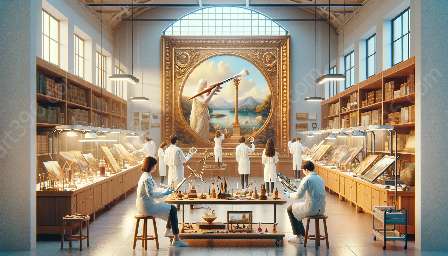Conservation in the context of modern and contemporary art is a complex process that involves balancing the preservation of original intent with the evolution of artistic expression. This delicate balance requires a deep understanding of the historical context and artistic intent while also acknowledging the changing nature of contemporary art.
Preservation of Original Intent
One of the primary goals of conservation in modern and contemporary art is to preserve the original intent of the artist. This involves careful examination of the artwork, including the artist's materials, techniques, and cultural context. By understanding the artist's intentions, conservators can make informed decisions about how to protect and maintain the integrity of the artwork.
- Materials and Techniques: Understanding the materials and techniques used by the artist is crucial for conservation. This includes identifying the specific paints, pigments, and supports chosen by the artist, as well as any unique or experimental techniques that may have been employed.
- Cultural Context: A comprehensive understanding of the cultural and historical context in which the artwork was created is essential for preserving the original intent. This includes considering the social, political, and artistic movements that influenced the artist.
Adapting to Contemporary Art
While preserving the original intent of artwork is paramount, conservation also involves adapting to the evolution of contemporary art. Contemporary artists often utilize new materials, technologies, and conceptual frameworks, challenging conservators to find innovative approaches to preserving these innovative artworks.
- New Materials and Technologies: Many contemporary artists utilize unconventional materials and technologies, such as digital media, interactive elements, and ephemeral installations. Conservators must develop new techniques for preserving and presenting these non-traditional artworks.
- Conceptual Frameworks: Contemporary art often explores complex and abstract concepts, requiring conservators to consider new interpretive frameworks for understanding and preserving the intention of the artist.
Significance of Art Conservation in Modern and Contemporary Art
Art conservation plays a crucial role in ensuring the longevity and accessibility of modern and contemporary art. By carefully balancing the preservation of original intent with the evolution of contemporary art, conservators contribute to the continued appreciation and understanding of these important cultural artifacts.
The preservation of original intent ensures that future generations can experience the artwork as the artist intended, providing valuable insights into the historical, social, and artistic context in which it was created. At the same time, the adaptation to contemporary art ensures that innovative and boundary-pushing artworks remain accessible and relevant.
In conclusion, conservation in modern and contemporary art is a dynamic and multifaceted process that requires a balance between preserving the original intent of the artist and adapting to the evolving nature of contemporary art. Through careful analysis, innovative techniques, and a deep appreciation for artistic expression, conservators play a vital role in safeguarding these important cultural treasures for future generations.

